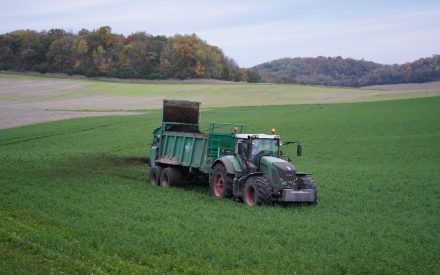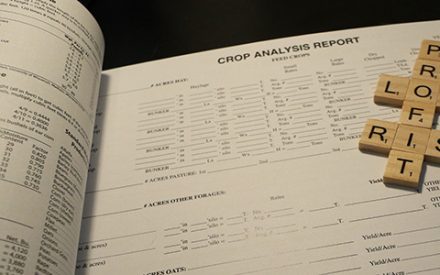Introduction
Small grains offer many opportunities and agroecosystem benefits within Wisconsin crop rotations. All small grains close the gap in fallow periods and provide opportunities for managing troublesome weed species, other pests, and manure. Winter annuals provide essential winter cover and reduce nutrient runoff.
Like any crop, small grains are susceptible to an array of diseases with fungal diseases being the most prominent. These diseases put grain yield and quality and straw feedability at risk. Fungal diseases thrive in moist, moderate temperature environments, thus making Wisconsin’s humid springs and summers the ideal environment. Mild winters are occurring at a greater frequency creating more favorable conditions for overwintering of fungal pathogens1.
Integrated with cultural control practices such as variety selection for disease resistance and crop rotation, fungicides can be an important tool of integrated disease management. Fungicides work best when applied before disease develops or very early in development. Higher fungal disease risk and the reality of narrow optimum fungicide application windows mean that scouting and monitoring during favorable disease conditions is critically important.
Grain and Straw Quality Testing
Fungal diseases can impact grain quality, with some posing serious risks to livestock feed. One such disease, ergot, affects small grains and grassy weed species, producing toxic fungal structures in place of seeds2. Because perennial grass species are a host, it is important to control weeds and mow field edges.
Fusarium head blight (FHB), commonly known as head scab, is another major concern for small grain producers, predominantly winter wheat growers. Not only can FHB cause significant yield decline but it can often produce a mycotoxin called deoxynivalenol (DON), known as vomitoxin. While FHB often leads to high levels of DON in the grain, DON can also be problematic in straw harvested from small grain crops, due to its high water solubility. DON can be leached from the head to the straw during rain events close to harvest.
DON Concentration for Feed and Food-Grade Grains
Testing of both the grain and straw should be done to monitor DON concentrations in these plant parts3. The maximum DON level in animal feed is ≤ 10 ppm for beef cattle and poultry and ≤ 5 ppm for swine and other animals4. Dairies require DON levels to be at less than 1 ppm for finished rations. Grain testing as low as 2 ppm can lead to dockage at the elevator or even rejection.
Food-grade small grains must meet strict quality standards. For safety, food-grade small grains are tested for DON and ergot, in addition to often being tested for genetically modified organisms and allergens. Grains meant for human consumption are limited to a threshold of 1 ppm DON in finished grain products as set and measured by the Food and Drug Administration (FDA)5. This low threshold means that control of the fungal diseases which produce mycotoxins is critical.
Fungicide Application and Timing for Small Grains
Proper fungicide use and timing are key to reducing fungal disease pressure. The first disease management step in small grains is using a seed treatment at planting to protect against decay, damping-off, and seedling blights caused by soil and seed-borne pathogens. Publication A3646 details available seed treatments6. Always refer to the product label being used in addition to this guide.
Selecting Effective Fungicides
Available fungicides belong to three mode of action groups, signified by Fungicide Resistance Action Committee (FRAC) codes. Mutations within fungal populations lead to lower product efficacy. Repeated use of the same fungicide mode of action can cause resistance. Thus, it is important to alternate modes of action or use mixed-mode-of-action products to slow fungicide resistance development.
Generally, fungicides will provide broad-spectrum control against various fungal pathogens affecting small grains. It is not recommended (and strobilurin fungicides are not labeled for use after heading) to use strobilurin fungicides on FHB because of the lack of control, and they may worsen DON levels.
Timing Fungicide Applications
Small grains’ flag leaf is the most important leaf for grain yield, thus the timing of fungicide application for most foliar fungal diseases is between flag leaf emergence and flowering. However, in Wisconsin, fungal foliar disease may not be active at this time. Thus, scouting and paying attention to the weather can help make the decision to apply a fungicide or hold off for a later fungicide application.
FHB is a disease of the flower and seed. To have a positive impact on grain quality and reduce FHB infection, it is imperative to apply fungicide from the start of anthesis (50% of heads at Feekes 10.5.1 in Figure 1) to 7 days after the start of anthesis. This is the most important fungicide application to be made to small grains in Wisconsin and will be required in most years to maximize DON reduction in small grains.

For a more in-depth look at the different small grains growth stages, please visit the Winter Wheat Development and Growth Staging Guide.
Research in Wisconsin has demonstrated that the optimal timing of fungicide application to maximize FHB control and reduce DON in the finished grain is 5 days after the start of anthesis. Spraying earlier or later than the window described above, or after Feekes 10.5.4 (Figure 1), will reduce efficacy and may be off label7.
Note that fungicides can greatly suppress FHB when used properly, but full control is not possible. For information on the best fungicides for FHB management or other small grains disease management in general, check out the Fungicide Efficacy For Control of Wheat Diseases efficacy table or interactive Fungicide Efficacy Tool which contains university fungicide efficacy data from across the U.S. including Wisconsin.
The minimum volume for ground spray applications is 10 gallons per acre7. Using higher water volumes can increase coverage within small grain heads. Using coarse sprays, lowered boom heights, slower travel speeds, and dual-angled spray nozzles will help you properly apply fungicides and achieve maximum control.
It is important to remember the following guidelines for fungicide use:
- Scout your fields! Scouting every 2-3 days will help optimize fungicide application timing. Do not apply fungicide if there is no sign of disease or conditions are not favorable for disease development. Begin scouting at Feekes 5 or 6 (Figure 1) and continue regularly.
- Consider the risk factors for disease: temperature, humidity, field history, crop rotation, and variety selection.
- No-till fields are at a greater risk for fungal disease because fungal bodies are not buried by tillage.
- Small grains crops that follow corn crops are often at higher risk of fungal diseases, especially FHB
- Need help making the decision to apply a fungicide for FHB management? There is a fusarium prediction tool from Penn State University which uses weather information to help make that decision.
- Rotate fungicide mode of action or use mixed-mode-of-action products. Repeated use of the same fungicide can cause resistance, similar to herbicide and insecticide resistance.
- Follow the label. Application timing, amount, preharvest interval, and grazing and feeding restrictions are all important factors that will be listed on the label.
- If your crop plans change, make sure to follow pre-harvest intervals and any forage harvest restrictions.
Updated: May 15, 2025
Reviewed by: Dane Elmquist and Damon Smith
References
- Wisconsin’s changing climate: Impacts and solutions for a warmer climate. (2021). Wisconsin Initiative on Climate Change Impacts. Nelson Institute for Environmental Studies, University of Wisconsin-Madison and the Wisconsin Department of Natural Resources, Madison, Wisconsin.
- Rosenthal, S., Undersander, D., Smith, D., Grau, C., & Hudelson, B. (2024). Ergot D0050. Extension University of Wisconsin-Madison. https://pddc.wisc.edu/wp-content/blogs.dir/39/files/Fact_Sheets/FC_PDF/Ergot.pdf
- Bissonnette, K.M., Kolb, F.L., Ames, K.A., Bradley, C.A. (2018). Effect of Fusarium Head Blight Management Practices on Mycotoxin Contamination of Wheat Straw. Plant Disease 102: 6. https://doi.org/10.1094/PDIS-09-17-1385-RE
- Smith, D., Stanger, T., & Grau, C. (2024). Fusarium Head Blight (Scab) D0054. Extension University of Wisconsin-Madison. https://pddc.wisc.edu/wp-content/blogs.dir/39/files/Fact_Sheets/FC_PDF/Fusarium_Head_Blight.pdf
- Williams, K., Tautges, N., Mirsky, S., Hartman, A., & Dawson, J. (2023). The New Growers’ Guide to Producing Organic Food-Grade Grains in the Upper Midwest. https://cropsandsoils.extension.wisc.edu/files/2023/07/The-New-Growers-Guide-to-Producing-Organic-Food-grade-Grains-in-the-Upper-Midwest.pdf
- Dewerff, R., Bick, E., Liesch, P.J., Nice, G., Renz, M., Smith, D., Werle, R., & Kampa, J. (2025). 2025 Pest Management in Wisconsin Field Crops A3646. Extension University of Wisconsin-Madison. https://cropsandsoils.extension.wisc.edu/files/2025/01/A3646_2025_web.pdf
- Fungicide Management of Fusarium Head Blight in Cereals. (2025). Manitoba Crop Alliance Production Resources. https://mbcropalliance.ca/directory/production-resources/fungicide-management-of-fusarium-head-blight-in-cereals/

 BMPs of NMPs #3: Calculating Soil Erosion, PI, SCI, and Management Strategies
BMPs of NMPs #3: Calculating Soil Erosion, PI, SCI, and Management Strategies ▶ Fall 2025 Financial Assistance for Producers
▶ Fall 2025 Financial Assistance for Producers


